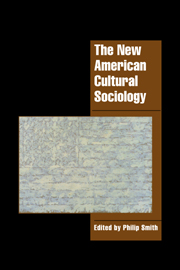Book contents
- Frontmatter
- Contents
- Notes on contributors
- Preface
- The new American cultural sociology: an introduction
- PART I Culture as text and code
- 1 Textuality and the postmodern turn in sociological theory
- 2 The computer as sacred and profane
- 3 AIDS and the discursive construction of homosexuality
- 4 Fundamentalism and liberalism in public religious discourse
- 5 Analytic and concrete forms of the autonomy of culture
- PART II The production and reception of culture
- PART III Culture in action
- Index
- Title in this Series
4 - Fundamentalism and liberalism in public religious discourse
Published online by Cambridge University Press: 18 January 2010
- Frontmatter
- Contents
- Notes on contributors
- Preface
- The new American cultural sociology: an introduction
- PART I Culture as text and code
- 1 Textuality and the postmodern turn in sociological theory
- 2 The computer as sacred and profane
- 3 AIDS and the discursive construction of homosexuality
- 4 Fundamentalism and liberalism in public religious discourse
- 5 Analytic and concrete forms of the autonomy of culture
- PART II The production and reception of culture
- PART III Culture in action
- Index
- Title in this Series
Summary
Every community is awash in words. Religious communities are no exception. Sermons, prayers, singing, creedal recitations, and discussion groups make up the very being of such communities.
In recent years the flow of religious discourse has spilled into the public arena with increasing intensity. Religious broadcasts fill the airwaves and direct-mail solicitations fill our mailboxes. Bishops issue statements on social issues such as nuclear disarmament and economic justice. A pope stumps the country delivering homilies. Preachers become presidential candidates. And media specialists try to make sense of it all.
Social scientists have in recent decades developed a fairly standard way of studying the relations between religion and public affairs. Opinion polls are the method of choice, supplemented by occasional applications of content analysis, in-depth interviews, and discussion of broader social developments to provide context. As a result of this often valuable research, we have a good sense of the public's tolerance for religious leaders making statements about various kinds of social issues. We also have some evidence on the issues clergy say they speak about. And we have many studies of the ways in which religious beliefs and attitudes towards social issues correlate: fundamentalism and bigotry, parochialism and conservatism, conservatism and views of the priesthood, moralism and attitudes towards abortion, religious preference and voter orientation. We even have frequency counts of the kinds of themes that are expressed on religious television shows or in religious books.
But on religious discourse as discourse we have virtually nothing. It is as if our standard methods have trained us to think of religious communities (and not just religious communities) as silent worlds. People have religious beliefs, convictions, and sentiments.
- Type
- Chapter
- Information
- The New American Cultural Sociology , pp. 60 - 72Publisher: Cambridge University PressPrint publication year: 1998
- 1
- Cited by

